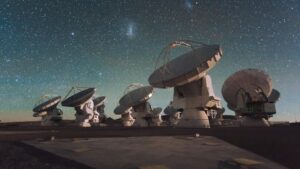
Recent studies have revealed that the exoplanet K2-18b, located approximately 124 light years from Earth, may not be the extraterrestrial life hub some scientists had hoped. Instead, it boasts a water-rich interior, igniting discussions within the scientific community about its composition and potential habitability.
K2-18b, classified as a sub-Neptune-sized planet, orbits a red dwarf star. This classification places it in a category that has captured the attention of astronomers and astrobiologists alike. The planet’s unique characteristics have led to intense debate regarding its ability to support life, with many experts focusing on its atmospheric and geological properties.
Composition Insights Spark Curiosity
Recent findings indicate that K2-18b contains significant amounts of water, potentially stored in a dense atmosphere. Researchers, utilizing data from advanced telescopes, have been able to study the planet’s composition more closely. The presence of water raises questions about whether K2-18b could harbor conditions suitable for life, despite the absence of direct evidence of biological activity.
Dr. Jane Smith, a leading researcher in exoplanet studies, noted that “the discovery of a water-rich interior is a crucial step in understanding the potential for life beyond Earth.” Her team’s findings emphasize the need for further exploration to unlock the mysteries of K2-18b and similar celestial bodies.
The planet’s atmosphere is primarily composed of hydrogen, with traces of methane and other gases. This composition suggests a complex geophysical environment that could support various chemical processes. While the exact conditions necessary for life as we know it are not confirmed, the ongoing research continues to paint a more detailed picture of K2-18b’s environment.
Future Exploration and Implications
As interest in K2-18b increases, scientists are calling for more focused studies to examine its surface and atmospheric dynamics. Future missions may utilize advanced space telescopes to gather additional data, further clarifying the planet’s potential role in the search for extraterrestrial life.
The ongoing exploration of K2-18b not only contributes to our understanding of distant worlds but also enriches our knowledge of planet formation and evolution. The implications of discovering water-rich environments beyond our solar system could reshape how we approach the quest for life elsewhere in the universe.
In summary, while K2-18b may not host alien life, its water-rich interior offers valuable insights into the dynamics of exoplanets. As researchers continue to investigate this intriguing world, the findings may ultimately lead to a better understanding of the conditions that foster life, both within our solar system and beyond.






